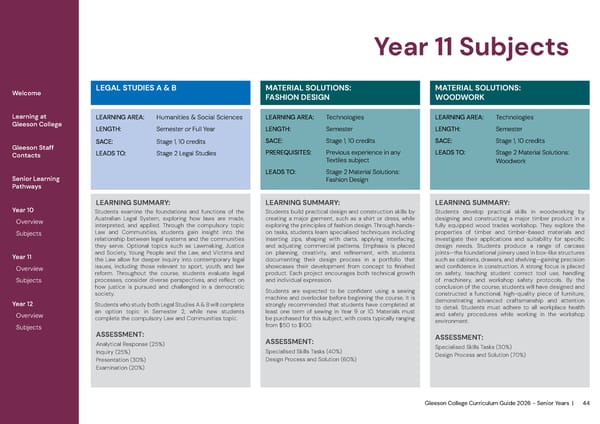Gleeson College Curriculum Guide 2026 - Senior Years | 44 Year 11 Subjects Welcome Learning at Gleeson College Gleeson Staff Contacts Senior Learning Pathways Year 10 Overview Subjects Year 11 Overview Subjects Year 12 Overview Subjects LEARNING SUMMARY: Students examine the foundations and functions of the Australian Legal System, exploring how laws are made, interpreted, and applied. Through the compulsory topic Law and Communities, students gain insight into the relationship between legal systems and the communities they serve. Optional topics such as Lawmaking, Justice and Society, Young People and the Law, and Victims and the Law allow for deeper inquiry into contemporary legal issues, including those relevant to sport, youth, and law reform. Throughout the course, students evaluate legal processes, consider diverse perspectives, and reflect on how justice is pursued and challenged in a democratic society. Students who study both Legal Studies A & B will complete an option topic in Semester 2, while new students complete the compulsory Law and Communities topic. ASSESSMENT: Analytical Response (25%) Inquiry (25%) Presentation (30%) Examination (20%) LEGAL STUDIES A & B LEARNING AREA: Humanities & Social Sciences LENGTH: Semester or Full Year SACE: Stage 1, 10 credits LEADS TO: Stage 2 Legal Studies MATERIAL SOLUTIONS: FASHION DESIGN LEARNING AREA: Technologies LENGTH: Semester SACE: Stage 1, 10 credits PREREQUISITES: Previous experience in any Textiles subject LEADS TO: Stage 2 Material Solutions: Fashion Design LEARNING SUMMARY: Students build practical design and construction skills by creating a major garment, such as a shirt or dress, while exploring the principles of fashion design. Through hands- on tasks, students learn specialised techniques including inserting zips, shaping with darts, applying interfacing, and adjusting commercial patterns. Emphasis is placed on planning, creativity, and refinement, with students documenting their design process in a portfolio that showcases their development from concept to finished product. Each project encourages both technical growth and individual expression. Students are expected to be confident using a sewing machine and overlocker before beginning the course. It is strongly recommended that students have completed at least one term of sewing in Year 9 or 10. Materials must be purchased for this subject, with costs typically ranging from $50 to $100. ASSESSMENT: Specialised Skills Tasks (40%) Design Process and Solution (60%) MATERIAL SOLUTIONS: WOODWORK LEARNING AREA: Technologies LENGTH: Semester SACE: Stage 1, 10 credits LEADS TO: Stage 2 Material Solutions: Woodwork LEARNING SUMMARY: Students develop practical skills in woodworking by designing and constructing a major timber product in a fully equipped wood trades workshop. They explore the properties of timber and timber-based materials and investigate their applications and suitability for specific design needs. Students produce a range of carcase joints—the foundational joinery used in box-like structures such as cabinets, drawers, and shelving—gaining precision and confidence in construction. A strong focus is placed on safety, teaching student correct tool use, handling of machinery, and workshop safety protocols. By the conclusion of the course, students will have designed and constructed a functional, high-quality piece of furniture, demonstrating advanced craftsmanship and attention to detail. Students must adhere to all workplace health and safety procedures while working in the workshop environment. ASSESSMENT: Specialised Skills Tasks (30%) Design Process and Solution (70%)
 2026 Gleeson College Senior Years Curriculum Guide 2026 Page 43 Page 45
2026 Gleeson College Senior Years Curriculum Guide 2026 Page 43 Page 45